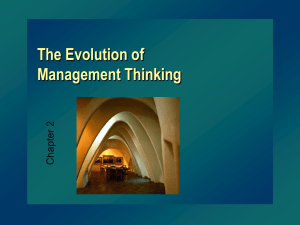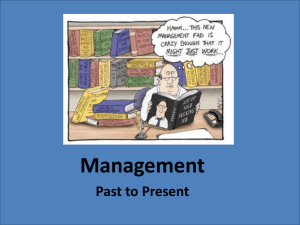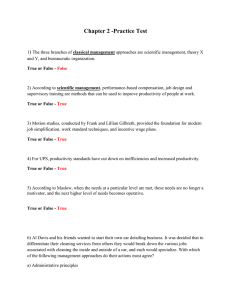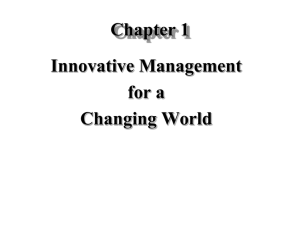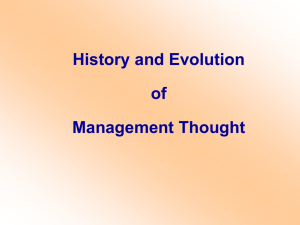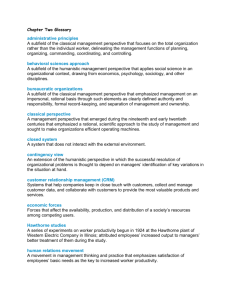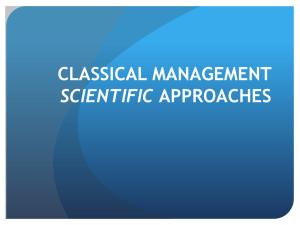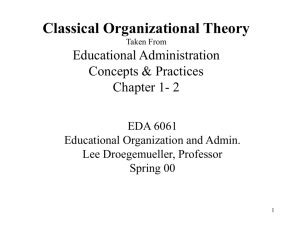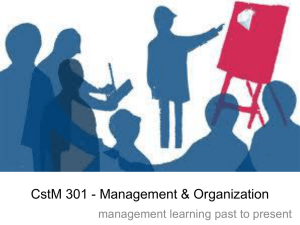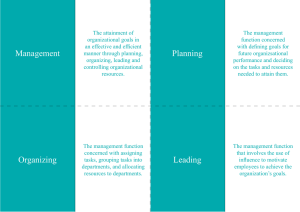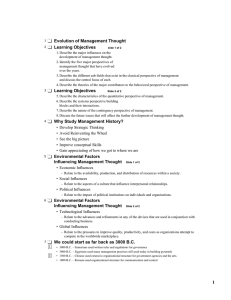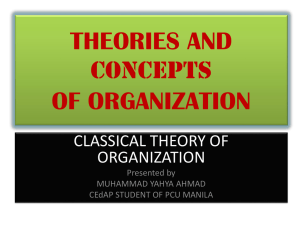Chapter 2
advertisement
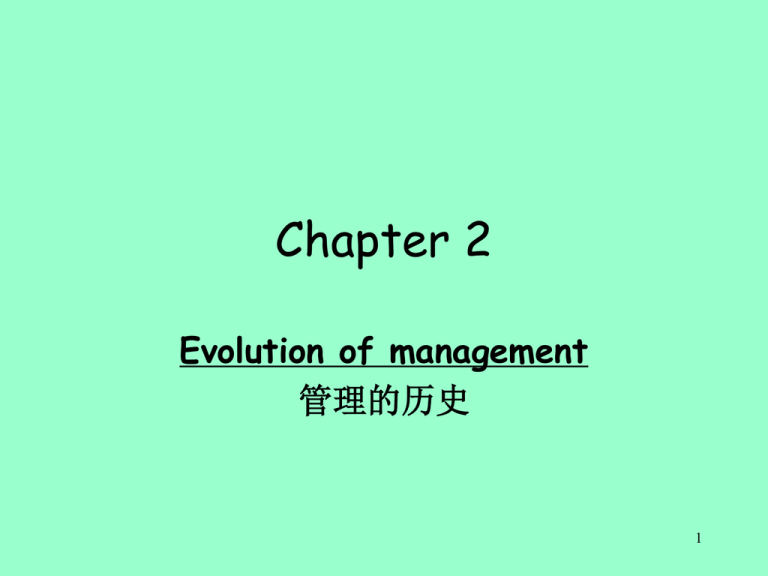
Chapter 2 Evolution of management 管理的历史 1 Objectives • Understand how historical forces influence the practice of management • Identify and explain the major developments in the history of management thought • Describe the major components of the classical and humanistic management perspective • Discuss the management science perspective and its current use in organizations • Explain the major concepts of systems theory, the contingency theory, and total quality management • Describe the learning organization and the changes in structure, empowerment, and information sharing managers make to support it • Discuss the technology-driven workplace and the role of enterprise resource planning and knowledge management systems 2 Topics to be discussed 1. 2. 3. 4. 5. 6. 7. Management and Organization 管理与组织 Classical Perspective 古典管理理论 Humanistic Perspective 人本主义理论 Management Science Perspective 管理科学理论 Recent Historical Trends 发展趋势 The Learning Organization 学习型组织 Technology-driven workplace 技术驱动下的工作 场作 3 影响组织和管理的因素 Influences that Impact Org.& Management • Social Forces 社会力量 –The aspect of a culture that guide and influence relationships among people –values, needs, and standards of behavior • Political Forces 政治力量 –The influence of political and legal institutions on people & organizations • Economic Forces 经济力量 –Forces that affect the availability, production, & distribution of a society’s resources among competing users 4 管理观点的演进 Management Perspectives Over Time 2000 The Technology-Driven Workplace 1990 The Learning Organization 1980 Total Quality Management Contingency Views 2010 2010 2000 1970 2000 1950 Systems Theory 2000 1940 Management Science Perspective 1990 1930 Humanistic Perspective Classical 1990 1890 1940 5 古典管理理论 Classical Perspective • Scientific Management 科学管理 – Taylor,《科学管理的原理》 • Bureaucratic Organizations官僚式组织 – Weber,《社会和经济组织》 • Administrative Principles行政管理原则 – Fayol,《工业管理与一般管理》 前往: 人本主义理论 6 科学管理的特点 Characteristics of Scientific Management General Approach • Developed standard method for performing each job. • Selected workers with appropriate abilities for each job. • Trained workers in standard method. • Supported workers by planning work and eliminating interruptions. • Provided wage incentives to workers for increased output. Contributions • Demonstrated the importance of compensation for performance. • Initiated the careful study of tasks and jobs. • Demonstrated the importance of personnel and their training. Criticisms • Did not appreciate social context of work and higher needs of workers. • Did not acknowledge variance among individuals. • Tended to regard workers as uninformed and ignored their ideas. 7 官僚式组织 Bureaucracy Organizations • Labor is divided with clear definitions of authority and responsibility. • Positions are in hierarchy of authority. • Personnel are selected and promoted based on qualifications. • Management is separate from the ownership. • Rules and procedures ensure reliable, & predictable behavior. • Rules are impersonal and uniformly applied. SOURCE: Adapted from Max Weber, The Theory of Social and Economic Organizations, ed. and trans. A.M. Henderson and Talcott Parsons (New York: Free Press, 1947), 328-337. 8 行政管理原则 Administrative Principles • Contributors to this approach – Henri Fayol – Mary Parker – Chester I. Barnard • Focused on organization rather than the individual • Delineated the management functions of planning, organizing, commanding, coordinating, and controlling 9 管理的14条原则 Henri Fayol’s 14 Points Division of labor分工 Authority权力 Discipline纪律 Unity of command统一 命令 Unity of direction统一领 导 Subordination of individual interest 个人 利益服从整体利益 Remuneration员工报酬 Centralization集权 Scalar chain等级链 Order秩序 Equity平等 Stability and tenure of staff员工稳定 Initiative主动性 Esprit de corps集体精神 10 人本主义理论 Humanistic Perspective • Human Relations Movement 人际关系运动 – Hawthorne Studies • Human Resource Perspective 人力资源观点 – Maslow:需要层次论 – Mcgregor:XY理论 • Behavioral Science Approach 行为科学方法 – Develops theories about human behavior based on scientific methods & study – Applies social science in an organizational context – draws from economics, psychology, sociology in understanding employees – 运用社会学、心理学、经济学、人类学等方法研究人的行为来解 决管理问题 前往: 11 管理科学理论 霍桑试验 Hawthorne Studies • Ten year study • Four experimental & three control groups • Five different tests • Test pointed to factors other than illumination for productivity • 1st Relay Assembly Test Room experiment, was controversial, test lasted 6 years • Interpretation, money not cause of increased output • Factor that increased output, Human Relations 12 需要层次论 Abraham Maslow’s Hierarchy General Examples Self-fulfillment Self-actualization 自我实现的需要 Organizational Examples Challenging Job Status Esteem 尊重需要 Job Title Friendship Belonging 归属需要 Friends Stability Shelter Safety 安全需要 Physiological 生理需要 Retirement Plan Wages Based on needs satisfaction 13 XY理论 Douglas McGregor:Theory X & Y Theory X Theory Y X理论 Y理论 • • • • • People are lazy People lack ambition Dislike responsibility People are self-centered People don’t like change • People are energetic • People want to make contributions • People do have ambition • People will seek responsibility 14 管理科学理论 Management Science Perspective • Emerged after WW II Operations Research 运筹学 mathematical modeling • Distinguished for its Operations Management运营管理 application of specializes in physical mathematics, statistics production of goods or services to problem solving Information Technology 信息技术 • 应用数学、统计和其 reflected in management 它定量技术来进行决 information systems 策和解决管理问题 15 发展趋势 Recent Historical Trends Systems Theory 系统理论 System系统 为实现共同目标的相关部件的结合体 Entropy熵 系统由衰退而走向死亡的趋势 Synergy协同 整体大于部分之和 Subsystems子系统 彼此相互依赖的各项构成要素 Contingency View 权变理论 Total Quality Management (TQM) 全面质量管理 16 前往: 学习型组织 系统理论 Systems View 17 权变理论 Contingency View 18 学习型组织 Learning Organization • An organization in which everyone is engaged in identifying and solving problems, enabling the organization to continuously experiment, improve, and increase its capability • 组织中的所有员工都致力于识别和解决问题。 并使组织持续地进行试研、变革、改进,从而 使其成长能力、学习能力和实现其目标的能力 不断提高。 • 与旨在获得效率与目的的传统组织相比,其核 心的思想是解决问题。 19 学习型组织的要素 Elements of a Learning Organization Team-Based Structure 基于团队的结构 Empowered Employees 员工授权 Learning Organization Open Information 公开信息 20 Tutorial Questions • Contrast the 3 major approaches within the Classical / Traditional Approach: Scientific, Bureaucratic and Administrative Management. Give examples of how these sub-approaches are reflected in an organization with which you are familiar. • Explain the main ideas underlying the Systems Theory pertaining to how an organization conducts its business (illustrate with a diagram). • Differentiate between the 3 main approaches within the Humanistic perspective. • Why is it important to understand the different perspectives and approaches to management theory that have evolved throughout the history of organizations? 21 Case Study • SuperJuice – What are some of the social, political, and economic forces affecting SuperJuice and calling for a new approach to management? – What do you believe Luisa needs to do first to begin a transformation at SuperJuice? – How would you suggest she turn SuperJuice into a learning organization? Think about specific changes she can make to get all employees thinking of new and exciting ways to revitalize the SuperJuice product line and way of doing business. 22
